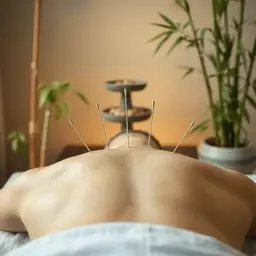Pain Management
Acupuncture alleviates pain by stimulating the body’s natural painkillers.
Subscribe to get the latest insights and updates straight to your inbox.
Posted on: 2025-07-07
By: Kaiya Whitmore
What if the secret to enhancing athletic performance lies in an ancient practice? Acupuncture is increasingly showing its potential in sports medicine, offering athletes innovative ways to manage pain and expedite recovery. As you delve into this article, you'll uncover the invaluable insights that acupuncture has to offer for sports injuries.
Acupuncture offers various advantages for athletes dealing with sports injuries, enhancing their recovery and performance. Below are some key benefits illustrated visually.
Acupuncture alleviates pain by stimulating the body’s natural painkillers.
Inserting needles increases blood flow, crucial for healing.
This technique helps decrease swelling, a significant concern for athletes.
Acupuncture assists in restoring flexibility and mobility.
Acupuncture has been quietly making waves in the world of sports medicine. Have you ever heard how professional athletes turn to this ancient practice for a boost in performance and recovery? As a passionate advocate for acupuncture, I've seen firsthand how it offers effective solutions for various sports-related injuries, making it an essential component of holistic health. Let's explore the vital role acupuncture plays in treating these injuries.
At its core, acupuncture is about more than just needles; it's about understanding the body’s energy, or *Qi*, and how to promote healing through targeted interventions. This practice can significantly aid in reducing inflammation, alleviating pain, and speeding up recovery times for athletes. By integrating acupuncture into a comprehensive treatment plan, athletes can not only recover faster but also enhance their overall performance.
When it comes to sports injuries, acupuncture serves as a complementary therapy, working alongside conventional modalities. This approach helps in various ways, including:
While traditional treatments like rest and ice are often utilized, incorporating acupuncture can elevate the healing process to new heights. At Acupuncture Perspectives, we emphasize understanding the athlete's unique situation, tailoring treatments that resonate with their individual needs.
In the realm of sports medicine, various acupuncture techniques can be employed to address specific injuries and conditions. Here are some common techniques and their applications:
Understanding these techniques allows practitioners to select the best approach for each athlete's needs. Through careful evaluation and personalized treatment plans, we at Acupuncture Perspectives strive to maximize the benefits of acupuncture in sports medicine.
Acupuncture is deeply rooted in Traditional Chinese Medicine (TCM), which views health as a balance between *Yin* and *Yang*. The principles of TCM provide a profound understanding of how acupuncture works. Key concepts include:
By integrating these principles into acupuncture treatments, practitioners can address not only the injury but also the underlying issues contributing to the athlete’s condition. At Acupuncture Perspectives, we emphasize this holistic view to foster a deeper connection between the patient’s experiences and their healing journey.
Did you know? Combining acupuncture with other therapies, such as physical therapy or massage, can enhance recovery outcomes. This integrative approach not only addresses the injury itself but also improves overall physical and mental well-being, allowing athletes to perform at their best.
When it comes to sports injuries, many athletes and fitness enthusiasts often wonder how acupuncture can help. At Acupuncture Perspectives, I frequently receive questions about the effectiveness and application of this ancient practice in modern sports medicine. Understanding what types of sports injuries can be treated with acupuncture is a key starting point for anyone considering this therapy. Below, I’ll break down some common inquiries that come up regarding acupuncture and its role in sports injury recovery.
Acupuncture is versatile and can address a wide range of sports injuries. Here are some common injuries that respond well to this treatment:
By targeting these specific injuries, acupuncture can help to reduce inflammation, improve blood circulation, and promote faster healing. This holistic approach often complements other treatments, providing a well-rounded recovery strategy.
Acupuncture facilitates pain relief through several mechanisms. Firstly, it stimulates the body’s natural pain-relieving chemicals, such as endorphins. Secondly, it promotes blood flow to affected areas, which can enhance healing. Here’s how it typically works:
By understanding these processes, athletes can appreciate how acupuncture can be an integral part of their recovery plan.
Pain assessment is crucial in determining the best acupuncture approach for sports injuries. By identifying trigger points—specific areas of muscle or connective tissue that are sensitive and tense—practitioners can target treatment more effectively. Here’s what I usually consider:
With this personalized approach, acupuncture can effectively address and alleviate pain, encouraging a quicker return to the activities you love!
Here are some common questions about using acupuncture for sports injuries:
As we explore the various facets of acupuncture in sports medicine, it’s clear that this ancient practice offers valuable insights and solutions for modern athletes. By considering the role of acupuncture, we can better understand how it supports recovery and enhances overall performance. If you’re curious about incorporating acupuncture into your recovery routine, I invite you to reach out to Acupuncture Perspectives for personalized insights and guidance!
In summary, acupuncture not only addresses a variety of sports injuries but also plays a significant role in pain relief and recovery. From muscle strains to joint pain, the benefits are profound, enhancing the healing process naturally. This is a practice that deserves more attention in the realm of sports medicine!
I encourage you to continue exploring the potential of acupuncture. Whether you're an athlete or someone interested in holistic health, there’s so much to discover. Have you ever considered how this ancient practice could complement your fitness journey?
As we move forward, integrating acupuncture with conventional treatments can amplify healing benefits. Whether through physiotherapy, chiropractic care, or nutritional guidance, combining these approaches can lead to even better outcomes. So, why not start a conversation about how acupuncture can fit into your recovery plan? For more insights, you might also explore scientific insights on acupuncture's effectiveness in various fields, or delve into acupuncture's role in global healthcare systems.
Here is a quick recap of the important points discussed in the article:

 Acupuncture, an ancient practice with roots in Traditional Chinese Medicine, has transcended cultura
Acupuncture, an ancient practice with roots in Traditional Chinese Medicine, has transcended cultura
 As the demand for alternative therapies grows, the need for well-trained acupuncturists becomes para
As the demand for alternative therapies grows, the need for well-trained acupuncturists becomes para
 As global health trends evolve, ancient practices like acupuncture are finding their place in modern
As global health trends evolve, ancient practices like acupuncture are finding their place in modern